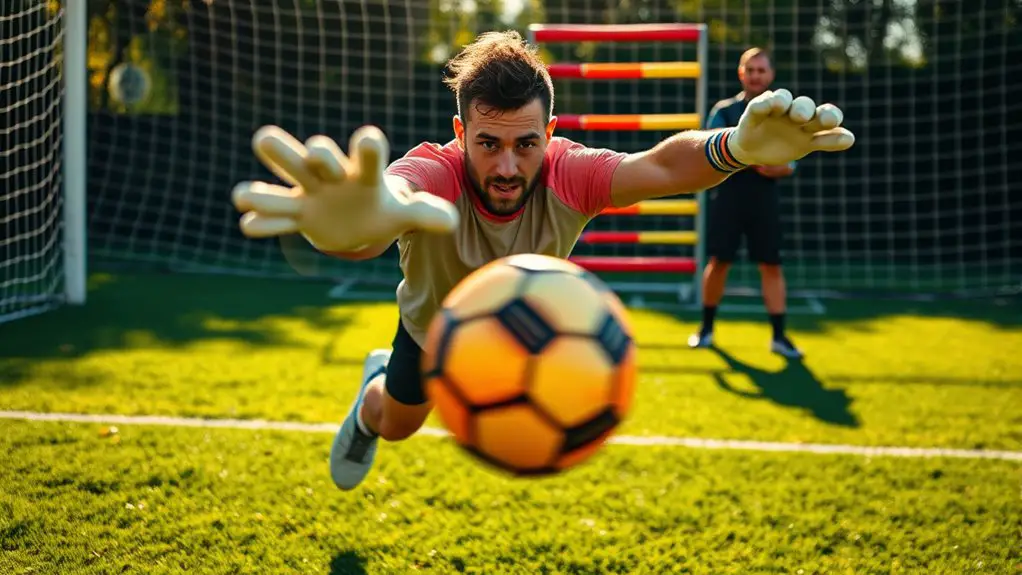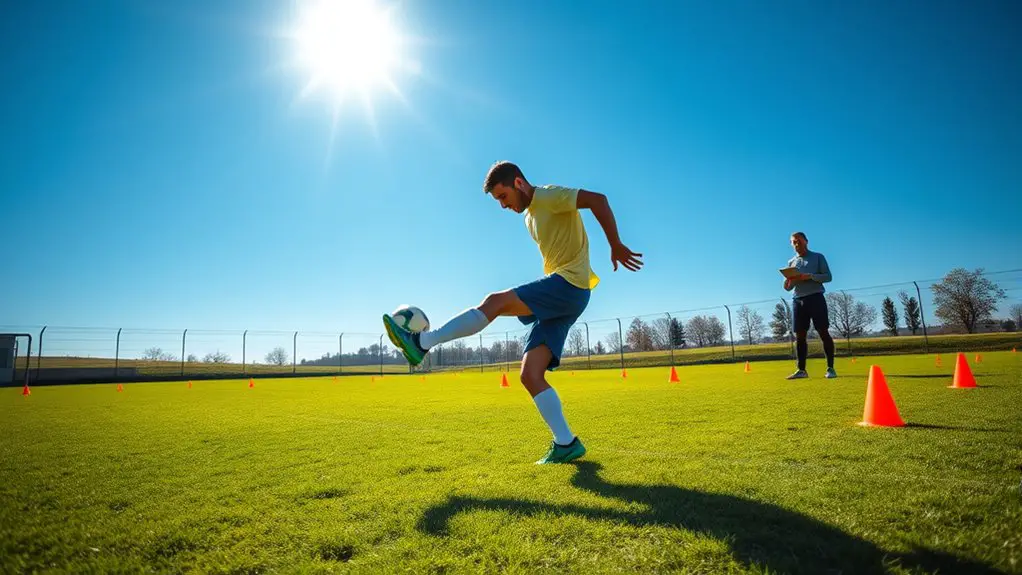To train for better climbing ability, start by evaluating your current skills and setting realistic, achievable goals. Develop a balanced strength training routine that includes bodyweight exercises and resistance training, focusing on climbing-specific movements. Improve your endurance with longer climbing sessions and interval training. Don't forget about flexibility and mental toughness, which are essential for success. Incorporate rest and recovery into your routine to optimize performance. There's more to discover about effective training strategies to enhance your climbing.
Assessing Your Current Climbing Ability
How can you truly measure your climbing skills? It starts with honest self-assessment. Use self-assessment tools like climbing journals or apps to track your progress. Document your climbs, noting routes, difficulties, and your feelings during each ascent. This awareness helps you understand your strengths and weaknesses.
Next, set performance benchmarks. Compare your results with established standards based on your climbing grade. Are you consistently reaching specific routes? If not, that's your cue to dig deeper. Challenge yourself, but be mindful of your limits.
Setting Realistic Training Goals
Setting realistic training goals is essential for improving your climbing ability. When you immerse yourself in goal setting, make sure your expectations align with your current skills and lifestyle. Instead of aiming to conquer the toughest routes overnight, focus on measurable improvements. Break your larger goals into smaller, achievable milestones that celebrate your progress. For instance, if you want to climb at a higher grade, set a timeline to gradually increase your difficulty level. This way, you're not just chasing an abstract dream; you're laying out a clear path to freedom in your climbing journey. Additionally, tracking your progress will help you identify effective strategies and keep you motivated along the way.
Developing a Strength Training Routine
While climbing requires a unique blend of strength, endurance, and technique, developing a targeted strength training routine can greatly enhance your performance. You can start by incorporating bodyweight exercises into your regimen, as they mimic the movements you'll experience on the rock. Think pull-ups, push-ups, and core work. These exercises build functional strength without the need for equipment, giving you the freedom to train anywhere.
Next, consider adding resistance training. This could involve using weights or resistance bands to focus on specific muscle groups essential for climbing, such as your back, shoulders, and legs. Resistance bands can enhance strength and muscle activation, allowing for a versatile and effective workout. Aim for a mix of both bodyweight and resistance approaches to create a well-rounded routine.
Improving Climbing Endurance
Building your strength is just one piece of the puzzle; improving your climbing endurance is equally important for tackling longer routes and challenging ascents. To boost your stamina, focus on endurance workouts that mimic the demands of climbing. Incorporate interval training to build your aerobic capacity while maintaining a climbing-specific approach.
Try doing longer, sustained climbs without resting, gradually increasing the time you spend on the wall. Mixing in stamina exercises like traversing or circuit climbing can also build your endurance effectively. Aim for sessions that last at least 30 to 45 minutes to condition your body for the climbs ahead. Additionally, engaging in enhanced cardiovascular endurance through cross-training activities like cycling or running can further elevate your climbing stamina.
Don't forget to listen to your body; rest days are vital for recovery. By prioritizing these endurance workouts, you'll find yourself enjoying the freedom of climbing longer routes with increased confidence and energy. Embrace the challenge, and you'll elevate your climbing game!
Enhancing Flexibility for Better Movement
To climb effectively, enhancing your flexibility is essential, as it allows for better movement and reach on challenging routes. Incorporating dynamic stretching and mobility exercises into your routine can help you achieve this. These practices prepare your body for the demands of climbing, promoting fluidity and reducing injury risk. Additionally, focusing on enhanced flexibility can significantly improve your overall performance and body awareness while climbing.
| Exercise Type | Benefits | Examples |
|---|---|---|
| Dynamic Stretching | Increases blood flow | Leg swings, arm circles |
| Mobility Exercises | Enhances joint range | Hip openers, thoracic twists |
| Static Stretching | Improves overall flexibility | Hamstring stretch, quadriceps stretch |
| Balance Training | Boosts stability | Single-leg stands, yoga poses |
| Core Strengthening | Supports body movement | Planks, Russian twists |
Mastering Climbing Techniques
Having improved your flexibility, you're now ready to focus on mastering climbing techniques that will elevate your skills on the wall. To truly release your potential, pay attention to the following key elements:
- Foot Placement: Prioritize precision in footwork; a good foothold can make all the difference.
- Body Positioning: Stay balanced and centered over your feet to maximize energy conservation.
- Hand Grip: Experiment with different grips; knowing when to use static holds versus dynamic movement is essential.
- Route Reading: Develop your problem-solving skills by visualizing your path before you climb.
Emphasizing movement fluidity and balance control enhances your climbing experience. As you practice these techniques, you'll find a sense of freedom on the wall, allowing you to tackle more challenging routes with confidence. Additionally, focusing on proper footwork will reduce the risk of injuries and improve your overall performance. Embrace the journey, and watch your climbing abilities soar!
Building Mental Toughness
Building mental toughness is just as essential as mastering your climbing techniques. You'll need to embrace discomfort and challenge, use visualization techniques to set yourself up for success, and practice positive self-talk to keep your motivation high. Additionally, developing a growth mindset allows you to view challenges as opportunities for improvement, which can greatly enhance your climbing experience. Let's explore how these strategies can transform your climbing experience.
Embrace Discomfort and Challenge
Although climbing often tests your physical limits, it's the mental challenges that truly shape your ability to succeed. To build mental toughness, you need to embrace discomfort and challenge yourself. Here are four ways to strengthen your mind:
- Embrace Failure: Learn from setbacks; they're opportunities for growth.
- Overcome Fear: Face your fears head-on; start with smaller challenges and gradually tackle bigger ones.
- Push Your Limits: Step outside your comfort zone; try new routes and techniques that intimidate you.
- Practice Mindfulness: Stay present during climbs; it helps reduce anxiety and enhances focus.
Visualization Techniques for Success
When you visualize your climbs, you're not just imagining success; you're programming your mind for it. Effective visualization methods can help you break through mental barriers and enhance your performance. Picture each move, feel the texture of the rock, and sense the exhilaration of reaching the top. This mental imagery creates a powerful connection between your mind and body, allowing you to tackle challenges with confidence. Spend a few minutes daily in a quiet space, focusing on your climbing goals. As you visualize, immerse yourself in the experience—see the route, hear the sounds around you, and feel the wind. By cultivating this mental toughness through visualization, you'll find greater freedom on the rock and in your climbing journey.
Positive Self-Talk Practices
One of the most effective ways to enhance your climbing performance is through positive self-talk. By harnessing affirmative affirmations, you can build mental toughness and boost your confidence. Here are some mindful motivation practices to incorporate into your climbing routine:
- Daily Affirmations: Start your day with powerful statements like, "I am strong and capable."
- Challenge Negative Thoughts: When doubt creeps in, counter it with a positive thought.
- Visualize Success: Picture yourself conquering difficult routes, reinforcing your belief in your abilities.
- Celebrate Progress: Acknowledge your achievements, no matter how small, to build a positive mindset.
Incorporating Rest and Recovery
Incorporating rest and recovery into your climbing training is essential for maximizing performance and preventing injuries. You need to listen to your body and recognize when it's time to take a break. Active recovery is a fantastic way to keep moving without pushing your limits—think light yoga, walking, or easy bouldering. These activities help promote blood flow and can speed up recovery. Additionally, incorporating proper nutrition strategies can significantly enhance your recovery process and overall performance.
Don't underestimate sleep importance either; it's when your body repairs itself and builds strength. Aim for quality sleep each night, as it's crucial for your physical and mental well-being. Prioritizing rest not only prepares you for your next climbing session but also enhances your overall climbing ability in the long run. So, embrace those rest days; they're just as essential as your training. Remember, freedom in climbing means knowing when to push and when to pause.
Utilizing Climbing Drills and Exercises
To enhance your climbing skills, it's vital to incorporate specific drills and exercises into your routine. These essential climbing drills not only build strength but also improve your technique on the wall. By focusing on targeted strategies, you'll see noticeable progress in your climbing ability. Additionally, incorporating hangboard training can significantly increase your grip strength, which is crucial for climbing success.
Essential Climbing Drills
While improving your climbing ability may seem challenging, utilizing essential climbing drills can make a significant difference in your performance. These drills focus on skill development, helping you climb with confidence and grace. Here are four key climbing drills to incorporate into your routine:
- Footwork Drills: Practice precise foot placements on various holds to enhance your balance and control.
- Silent Feet: Climb while minimizing noise from your foot placements, promoting smooth and deliberate movements.
- Flagging: Use your legs creatively to maintain balance and body position on challenging routes.
- Dynamic Movement: Work on reaching for holds with controlled jumps, enhancing your overall agility.
Strength-Building Exercises
Building strength is an essential aspect of improving your climbing ability, and integrating specific exercises into your routine can yield impressive results. Focus on strength training exercises like pull-ups, deadlifts, and core workouts to boost your overall power. These drills not only enhance your grip but also develop the muscles you rely on while scaling those heights. Remember, muscle recovery is just as vital; give your body the time it needs to repair and grow stronger. Incorporate rest days, light stretching, and proper nutrition to support your training. Listen to your body, and don't push too hard too fast. With dedication and the right approach, you'll feel your climbing skills soar, giving you the freedom to conquer new challenges.
Technique Improvement Strategies
Improving your climbing technique is just as essential as building strength, and incorporating specific drills can make a significant difference. Here are some effective strategies to enhance your climbing flow and movement efficiency:
- Foot Placement Drills: Focus on precise footwork to improve balance control and energy conservation.
- Body Positioning Exercises: Work on your body positioning to enhance grip techniques and momentum usage.
- Route Reading Practice: Visualize the route beforehand to optimize your climbing strategy and movements.
- Breathing Techniques: Incorporate controlled breathing to maintain focus and reduce fatigue during climbs.
Tracking Progress and Adjusting Your Training Plan
Tracking your progress is essential for enhancing your climbing ability. By keeping a record of your climbs, you can identify patterns and areas that need improvement. Use a climbing journal or an app to log your routes, grades, and how you felt during each session. This kind of progress tracking helps you visualize your development and stay motivated.
As you monitor your performance, be open to making training adjustments. If you notice persistent struggles on specific types of climbs, it might be time to tweak your training plan. Maybe you need to focus on strength, endurance, or technique. Embrace the freedom to explore different training methods and discover what works best for you. Remember, flexibility in your approach can lead to significant gains. Celebrate your progress, and don't hesitate to adapt your plan as you evolve as a climber.
Frequently Asked Questions
How Often Should I Change My Climbing Training Routine?
If you're stuck in the same routine, it's like climbing a flat wall—no thrill, no progress! You should switch up your climbing training every 4 to 6 weeks to keep things fresh. This way, you hit that sweet spot of progressive overload, pushing your limits while avoiding routine adaptation. Embrace the freedom to explore new techniques and challenges; it'll keep your passion alive and your muscles guessing. Keep it exciting, and you'll soar higher!
What Should I Eat Before Climbing Sessions?
Before your climbing sessions, it's essential to fuel up with the right pre-climb snacks. You'll want energy-boosting foods that keep you feeling light yet powerful. Think bananas, nut butter, or energy bars packed with healthy carbs and proteins. Avoid heavy meals that might weigh you down. Instead, aim for a balance that gives you the freedom to climb without feeling sluggish. Enjoy your climb while staying energized and focused!
Can Yoga Help Improve My Climbing Performance?
You might think yoga's too slow for climbing, but it offers incredible benefits. Practicing yoga can greatly enhance your flexibility training, allowing you to reach those tricky holds more easily. It also helps with balance and body awareness, which are essential for climbing efficiently. Plus, the mindfulness aspect of yoga can keep you calm under pressure, letting you focus on your moves. Embracing yoga could be the freedom your climbing routine needs!
How Can I Prevent Climbing-Related Injuries?
To prevent climbing-related injuries, you've gotta focus on injury prevention strategies. Start with thorough warm-up routines that increase blood flow and flexibility. Incorporate dynamic stretches to prepare your muscles and joints for the demands of climbing. Listen to your body—if something feels off, don't push it. Strengthening exercises for your core and grip can also help. Remember, taking care of yourself means you can enjoy the freedom of climbing longer and safer!
What Climbing Gear Is Essential for Beginners?
Did you know that over 70% of climbing injuries are due to equipment failure? As a beginner, you'll want to invest in some essential gear. A good climbing harness is vital for safety and comfort, allowing you to move freely while you explore. Don't forget a chalk bag, either; it helps keep your hands dry and improves your grip. With the right gear, you're set to embrace the thrill of climbing!




